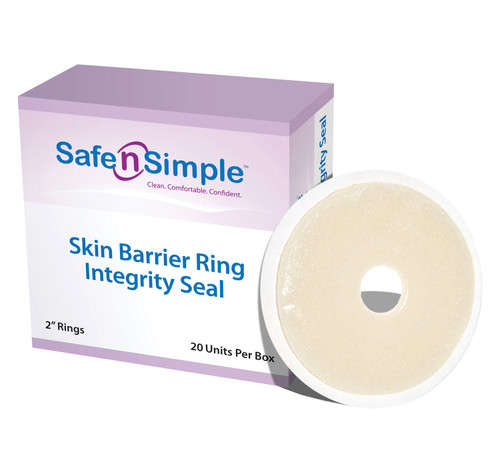Free Shipping On all orders over $100.00
HBF2650 Hydrofera Blue Ostomy Ring Dressing, (10 per box)
Hollister
- SKU:
- HBRF2650
HBRF2650 Hydrofera Blue® Ostomy Ring Dressings (10 per box)
A highly absorptive, non-adhesive, synthetic sponge composed of polyvinyl alcohol foam, impregnated with Methylene Blue and Gentian Violet, which provide broad-spectrum bacteriostatic protection. It is effective against a variety of microorganisms including MRSA and VRE. It has high filtering efficiency, extreme softness, excellent wicking and retention properties. The 2.5" ring dressing has a moisture retentive film backing, can be used under an ostomy skin barrier and won't interfere with adhesion of the barrier. Cut-to-fit up to 2".
- 10 per box
- 2-1/2" diameter ostomy dressing
- Dressing with moisture-retentive film backing
- HCPCS: A6209
- SKU# HBRF2650
The Hydrofera Blue Ostomy dressing is preferred over the Adapt Barrier Rings when a patient has severe irritation or an infection on the skin around the stoma. The Hydroferra Blue dressing has antibacterial qualities provided by the pigments within the dressing that make it a preferred choice over a normal ostomy ring like the Eakin Cohesive Seal, Adapt Barrier Ring, or Brava Ostomy Ring. The Hydroferra Blue Ostomy Ring is made of foam and is NOT moldable. It is placed directly on the skin with the shiny side facing out away from the skin.
How To Apply Hydrofera Blue® Ostomy Ring Dressing
- Remove Hydrofera Blue Bacteriostatic Dressing from the package and thoroughly moisten it with sterile saline or sterile water. Once Hydrofera Blue Bacteriostatic Dressing is thoroughly moistened, squeeze out excess liquid.
- Apply dressing to the wound. If the wound presents with surrounding erythema or rolled wound edges, the dressing should be larger than the wound to cover the periwound area. In other wounds, the dressing may be cut to fit the wound bed.
- Cover Hydrofera Blue Bacteriostatic Dressing with a secondary dressing to prevent displacement and to maintain moisture content. The secondary dressing selection is dependent on level of exudate. For example, if there is low exudate, a transparent film or impregnated gauze may be used. If there is heavy exudate, rolled gauze or a foam, such as Restore Hydro-Shield Foam Dressings, may be used.
- The first dressing change should occur at 24 hours. Examine the area of the dressing in contact with the wound bed. If the dressing has retained its blue color where it is in contact with the wound, apply a new dressing and leave in place for up to 72 hours. If the dressing has turned from blue to white or lightened in color, the dressing should be changed every 24 hours until it retains its blue color. The dressing should be changed anytime there is exudate strikethrough.
- Do not allow the dressing to completely dry out. Rehydrate the dressing as needed. If the dressing does dry out, thoroughly moisten it with sterile saline or sterile water, wait 2 minutes, then gently remove the dressing.







